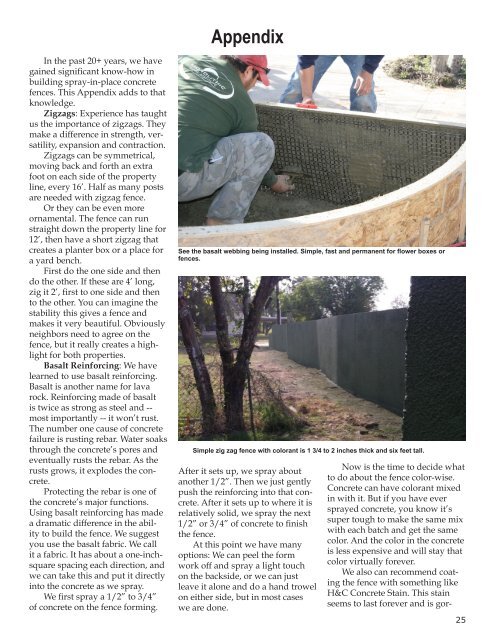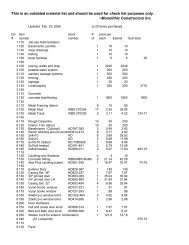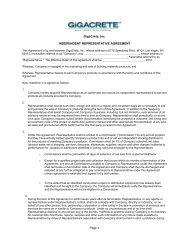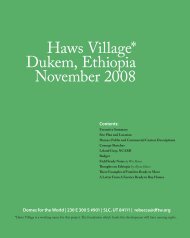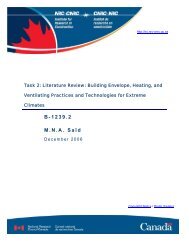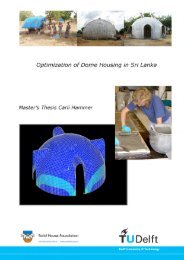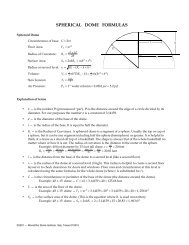How To Build A Spray-In-Place Concrete Fence - Monolithic
How To Build A Spray-In-Place Concrete Fence - Monolithic
How To Build A Spray-In-Place Concrete Fence - Monolithic
Create successful ePaper yourself
Turn your PDF publications into a flip-book with our unique Google optimized e-Paper software.
Appendix<br />
<strong>In</strong> the past 20+ years, we have<br />
gained significant know-how in<br />
building spray-in-place concrete<br />
fences. This Appendix adds to that<br />
knowledge.<br />
Zigzags: Experience has taught<br />
us the importance of zigzags. They<br />
make a difference in strength, versatility,<br />
expansion and contraction.<br />
Zigzags can be symmetrical,<br />
moving back and forth an extra<br />
foot on each side of the property<br />
line, every 16’. Half as many posts<br />
are needed with zigzag fence.<br />
Or they can be even more<br />
ornamental. The fence can run<br />
straight down the property line for<br />
12’, then have a short zigzag that<br />
creates a planter box or a place for<br />
a yard bench.<br />
First do the one side and then<br />
do the other. If these are 4’ long,<br />
zig it 2’, first to one side and then<br />
to the other. You can imagine the<br />
stability this gives a fence and<br />
makes it very beautiful. Obviously<br />
neighbors need to agree on the<br />
fence, but it really creates a highlight<br />
for both properties.<br />
Basalt Reinforcing: We have<br />
learned to use basalt reinforcing.<br />
Basalt is another name for lava<br />
rock. Reinforcing made of basalt<br />
is twice as strong as steel and --<br />
most importantly -- it won’t rust.<br />
The number one cause of concrete<br />
failure is rusting rebar. Water soaks<br />
through the concrete’s pores and<br />
eventually rusts the rebar. As the<br />
rusts grows, it explodes the concrete.<br />
Protecting the rebar is one of<br />
the concrete’s major functions.<br />
Using basalt reinforcing has made<br />
a dramatic difference in the ability<br />
to build the fence. We suggest<br />
you use the basalt fabric. We call<br />
it a fabric. It has about a one-inchsquare<br />
spacing each direction, and<br />
we can take this and put it directly<br />
into the concrete as we spray.<br />
We first spray a 1/2” to 3/4”<br />
of concrete on the fence forming.<br />
See the basalt webbing being installed. Simple, fast and permanent for flower boxes or<br />
fences.<br />
Simple zig zag fence with colorant is 1 3/4 to 2 inches thick and six feet tall.<br />
After it sets up, we spray about<br />
another 1/2”. Then we just gently<br />
push the reinforcing into that concrete.<br />
After it sets up to where it is<br />
relatively solid, we spray the next<br />
1/2” or 3/4” of concrete to finish<br />
the fence.<br />
At this point we have many<br />
options: We can peel the form<br />
work off and spray a light touch<br />
on the backside, or we can just<br />
leave it alone and do a hand trowel<br />
on either side, but in most cases<br />
we are done.<br />
Now is the time to decide what<br />
to do about the fence color-wise.<br />
<strong>Concrete</strong> can have colorant mixed<br />
in with it. But if you have ever<br />
sprayed concrete, you know it’s<br />
super tough to make the same mix<br />
with each batch and get the same<br />
color. And the color in the concrete<br />
is less expensive and will stay that<br />
color virtually forever.<br />
We also can recommend coating<br />
the fence with something like<br />
H&C <strong>Concrete</strong> Stain. This stain<br />
seems to last forever and is gor-<br />
25


